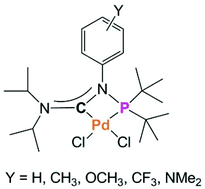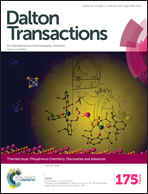Palladium(ii) complexes with chelating N-phosphanyl acyclic diaminocarbenes: synthesis, characterization and catalytic performance in Suzuki couplings†
Abstract
Complexes of palladium(II) with newly disclosed, N-phosphanyl acyclic diaminocarbene ligands are synthesized for the first time and structurally characterized. The ligands coordinate palladium(II) in a chelating fashion, yielding remarkably stable complexes which can be stored without special precautions in the solid state. Related palladium(II) complexes with an isomerized chelating ligand, formed upon 1,2-migration of the phosphanyl group from the nitrogen to the adjacent carbon atom, have also been isolated in some instances and structurally characterized. The complexes efficiently act as precatalysts for Suzuki coupling reactions of aryl chlorides, where their productivity compares favourably with that of related palladium complexes with acyclic diaminocarbene ligands. In addition, the complexes show a distinct tendency to form as the byproduct the reductive homocoupling product of aryl chloride. This observation, together with ad hoc performed control tests, suggests that Pd colloids are involved in the formation of catalytically competent species.

- This article is part of the themed collection: Phosphorus Chemistry: Discoveries and Advances

 Please wait while we load your content...
Please wait while we load your content...